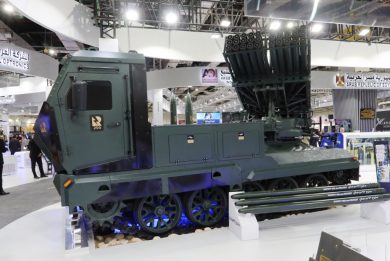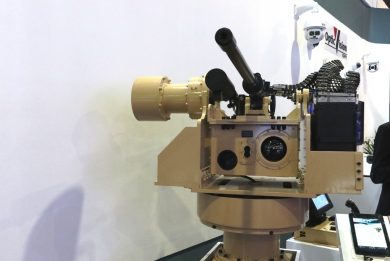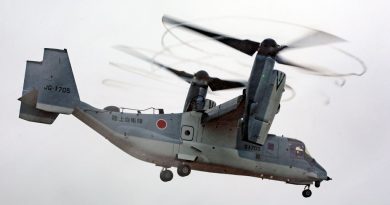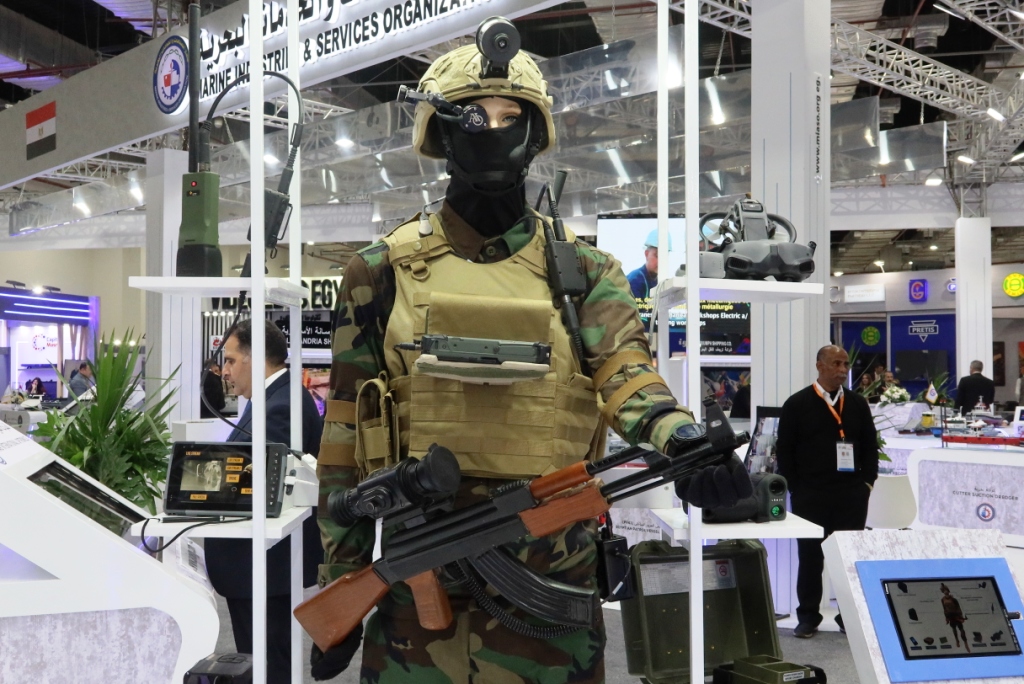
EDEX 2023 – AIO showcases the latest evolution of the Egyptian Integrated Soldier System
At EDEX 2023 Arab International Optronics exhibited the latest iteration of its Egyptian Integrated Soldier System, EISS in short, which is currently starting a first phase of testing with the Egyptian Army
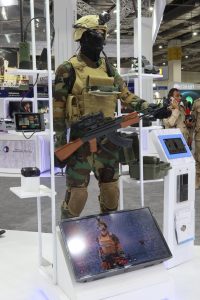
Seen in its previous form at EDEX 2018, the EISS sees AIO as the provider of some of the elements and as the system integrator, other elements being provided either by national or foreign companies, some of which are closely linked to AIO, the aim being to have in the end a wholly national product.
The Egyptian company is responsible for the software that manages the system, as well as for part of the optronics. Many of the EISS components have been acquired off-the-shelf and might be replaced in due course, however EDR On-Line will try to identify most of them, although no indications were provided by AIO.
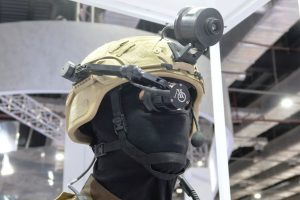
The ballistic helmet carries two AIO key components, the front thermal camera and the helmet eyepiece. The helmet is provided by VestGuard UK. And ensures an NIJ level IIIA protection level against firearms and a 650-700 m/s V50 against fragments, and is multi-hit tested. It is made of resin-bound aramid and is fitted with a four-point adjustable harness system with lockable dial. The helmet, which mass is around 1.5 kg depending on the size, is compatible with communication systems, night vision, goggles, gas masks, and other accessories. On the front of the helmet a thermal camera is installed, based on an uncooled 640×480 pixels sensor operating in the 8-14 µm LWIR band, with a 39 mm f. 1.6 lens providing a 31°x24° Field of View (FoV). The image captured by the camera is seen by the soldier on the helmet eyepiece, which can be mounted on the right or left of the helmet depending on the soldiers habits, and is equipped with an 800×600 pixels AMOLED SVG screen. No mass figures were provided for those two elements.
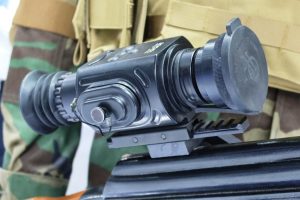
The eyepiece can also show the soldier a different image, that captured by the D27 uncooled aiming thermal sight, mounted on the assault rifle. It employs the helmet thermal sensor of the front camera, its 48 mm focal length lens providing a x2.4 magnification and a 12-9°x9.7° FoV, a x2 and x4 electronic zoom mode being also available. Data provided by AIO show a detection, recognition and identification ranges against vehicles and humans respectively of 3,250/1,100 metres, 1,100/350 metres and 550/200 metres. The image is shown on a screen similar to that of the helmet camera, but can be transferred to the helmet eyepiece; it can also be recorded either on the 32 GB internal memory or transferred to an external memory. The D27 has a mass of 650 grams with bracket but without battery, a rechargeable 18650 3.7 V battery which mass is around 45 grams, the system power consumption being 1.8 W. The battery status can be seen on the OLDED screen in the optic eyepiece.
The soldier can also be provided with a laser rangefinder monocular; the prototype system seen at Cairo was equipped with the LRM 2K by Newcon Optik of Canada, which is fitted with a lens providing x7 magnification and a 7.5° FoV. The Class 1 eye-safe laser works in the 905 nm wave length, measuring distance range being 10-2,000 metres with minimum accuracy of ±2 metres at distances over 500 metres. A pocketsize system, 106 x 76 x 39 mm, its mass is 235 grams without the 3V 850 mAh CR2 lithium battery which adds 11 grams to system mass. A single battery ensures at least 5,000 measurements.
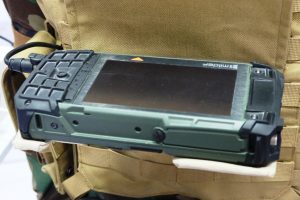
In the EISS prototype the ultra-rugged small form DB7 handheld device was provided by MilDef, the Swedish company specialised in tactical IT solutions. It is build around a 1.33 GHz Intel Atom Dual Core E3825 CPU with 1 MB L2 cache and 4-8 GB RAM. The human machine interface is a 5-inch 800×480 sunlight readable TFT (Thin Film Transistor) LCD LED B/L touch screen, with embedded speaker and microphone.
Usually only the squad leader is equipped with that subsystem, which runs of Windows 7, is relatively compact, 200 x 94 x 36 mm. weighs 675 grams and is powered by a 7.4 V / 3900 mAH Lithium-Ion primary battery.
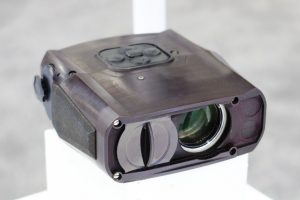
The same is true for the Osprey hand-held day/night which is fitted with a direct view optic, with a 4 km tank recognition range, and an uncooled thermal channel with a 14° FoV and a recognition range of 1 km against a tank. The device also contains a laser rangefinder with a 1.8 km range, and as option a GNSS receiver and a digital magnetic compass, these allowing target location. It can be connected to other systems via USB cable or wirelessly via Bluetooth and has a mass of 750 grams.

Communications are obviously a key component of the EISS. The system is radio agnostic, the one seen at EDEX being an ITT Spearnet Tactical Military Radio. This UHF radio operates in the 1.2-1.4 GHz band, and its 600 mW output ensures a nominal line-of-sight range of 2 km, which can be increased to 6 km “hopping” between radios, as it is MANET capable. . In provides secure voice, data and video transmission, with a 1.5 Mbps sustained rate and 6 Mbps burst rate. It has embedded situational awareness and eight preset channels. A compact system, 196 x 76 x 48 mm, it has a mass of less than 700 grams including battery.
Power is however also ‘provided by a central battery, carried by the soldier on his back. This is a Bren-Tronics BT-70838-2/3CV Li-ion battery with a mass of 390 grams operating at a nominal voltage of 10.8 V with a 6.8 Ah capacity. The company offers a series of soldier-portable chargers ensuring multiple-battery recharging.
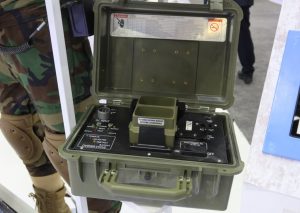
At squad level, 12 soldiers plus commander, a micro-UAV with VTOL capacity will be part of the kit. At EDEX we could see a commercial drone of Chinese origin, the DJI Avata, a 410 grams system with dimensions of 180×180×80 mm, capable to fly up to 27 m/s with a maximum hover time of 18 minutes. This model is probably being used for tests, a more rugged and militarised item being probably the final choice.
Last but not least comes the set of clothing that includes among others a 2.3 litres rehydration pouch, knee and elbow protections, etc. A body armour is also part of the kit, although it remains unclear if this is able to carry armour plates against high velocity rounds.
As said the one seed at EDEX was the first EISS prototype. AIO officials told EDR On-Line that during the exhibition the company the company was busy in producing other systems, in order to start field trials with the Egyptian Army in December.
Photos by P. Valpolini

